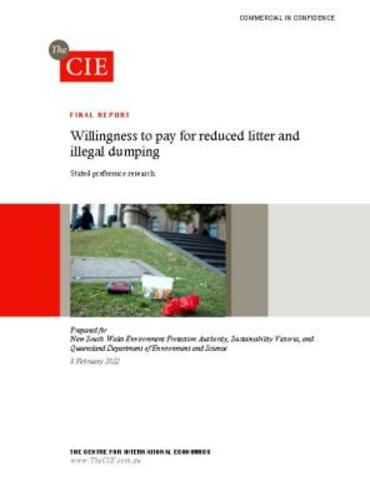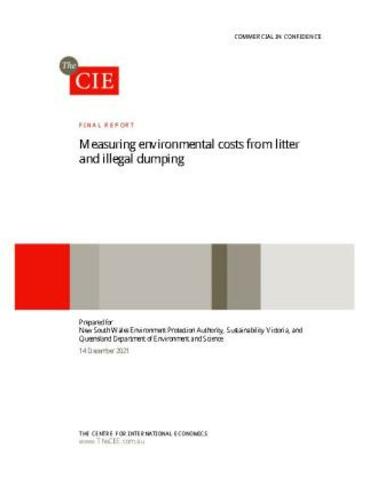Litter research
Research to help us understand impacts of litter, design evidence-based interventions, and ensure NSW's litter laws and prevention strategies protect the community and the environment.
Our litter research shows that 87% of NSW residents think litter is an important issue. It's easy to prevent litter every day:
- put your rubbish in a bin
- take your rubbish with you if no bin is available
- keep a bag in your car to collect rubbish
- put your cigarette butt in a butt bin, or an ordinary litter bin when extinguished
- keep a container in your car to collect cigarette butts
- buy less packaging and use reusable containers.
NSW litter reports by the EPA
Every two years the EPA reports on the composition and quantity of litter types in sites where significant littering takes place, as required under the Protection of the Environment Operations Act 1997 (POEO Act) section 146D.
The cost of litter in NSW
In 2021, research was developed into the indirect costs of litter. Indirect costs arise from the impacts of litter that is not cleaned up or that escapes into the wider environment before it can be cleaned up. To maximise the benefits of the research, the study covered the indirect costs of both littering and illegal dumping, which are treated in two reports that capture the different aspects of these costs:
- The Willingness to pay for reduced litter and illegal dumping – stated preference research report (PDF 12.7MB) covers the costs of the loss of visual amenity from littering and illegal dumping in public places
- The Measuring environmental costs from litter and illegal dumping report (PDF 6MB) covers the costs of environmental impacts from litter and illegally dumped material that escape into the NSW environment.
In 2016, the NSW Government commissioned a study into the costs of litter that estimated the direct financial outlay incurred by the community for cleaning up litter in NSW. The findings are presented in Litter Costs to the NSW Economy – a preliminary report (PDF 2.2MB).
EPA litter prevention kit
The EPA's litter prevention kits summarise research about littering and the behaviour behind it.
- Part 1: Things you should know about litter and litterers (PDF 43KB)
covers the laws, behaviours, publication perceptions and trends behind littering in NSW - Part 2: Delivering effective local prevention projects (PDF 2.3MB)
covers the information, actions, and partners you’ll need to engage in your community to tackle litter, as well as tools to measure your success - Part 3: Local Litter Check Guidelines (PDF 2.2MB)
tools to help you gather evidence to find out about litter in your local area - Part 4: Butt Litter Check Guidelines (PDF 2MB)
tool to understand why smokers may be littering cigarette butts, and to develop evidence-based interventions to prevent cigarette butt litter
Litter leakage from waste collection services
In late 2021 a pilot study was conducted to explore the contribution of kerbside rubbish collections to litter generation.
The study used a count of litter pre and post rubbish bin collection and bin observations. Fieldwork centred on litter hotspots in the Canterbury Bankstown local government area (LGA). A considerable amount of litter was observed, with 43% of residential properties having litter on the front verge and footpath, even prior to rubbish collection. Paper and cardboard (45%) and soft plastics (43%) were the most littered items.
We are looking to revise the methodology and expand the study and scope across further NSW LGAs.
Effectiveness of fines in reducing and preventing littering behaviour
In late 2021, we completed a report on the effectiveness of littering. Are fines for littering effective in reducing and preventing littering behaviour in NSW? (PDF 4.7MB) included a literature review, fine data analysis, surveys and interviews of state and local government agencies, and well as people who have been fined for littering.
The report will inform NSW litter prevention strategies, future litter enforcement campaigns we run and support local with on-ground litter enforcement in NSW.
Vaping device use and recovery systems report
When disposed of incorrectly, vaping device components can enter our environment via the leaking of toxic substances from e-liquids and corrosive electrolytes, leaching of toxic heavy metals from electronic circuitry, cause plastic pollution and start fires from lithium-ion batteries. The Vaping device use and recovery systems report (PDF 2.6MB) helps us better understand and respond to an item that is increasingly entering our environment.
Cigarette butt litter prevention
We conducted research to understand smokers’ behaviour, attitudes, and knowledge towards cigarette butt disposal. This includes understanding the barriers and incentives to breaking habits and adopting appropriate butt disposal actions. This research helped to guide the development of interventions and strategies to influence smokers’ disposal behaviour. These strategies were later tested in a behaviour change trial, to determine the most effective strategies to reduce cigarette butt litter.
Download

Willingness to pay for reduced litter and illegal dumping Willingness to pay for reduced litter and illegal dumping

Download

Measuring environmental costs from litter and illegal dumping Measuring environmental costs from litter and illegal dumping
